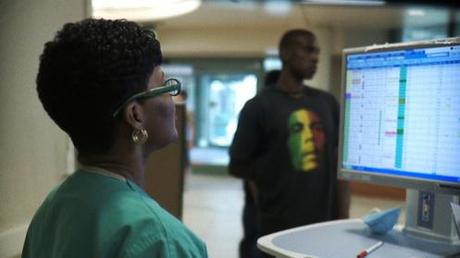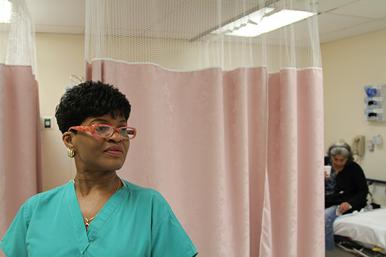Finally finding a bit of time in my hectic life to start fully reviewing the films of the True/False Fest, I decided to start with the social documentary called The Waiting Room. Also I was spurred on to do this review after being contact through twitter by the official Waiting Room handle, which promptly corrected me on the misspelling of the directors name Pete Nicks. So embarrassment aside, I wanted to actually give this a full review instead of the small snippet of coverage.
To be frank and continue my traditional insight before diving into the film, healthcare in this country is one of the most heated topics of debate in this country. I am of the notion that a country as prosperous and great as we are, it is a shame that we cannot provide healthcare to everyone in America. It says something about a country and the way they treat their citizens when getting ill is the difference between life and death. Sometimes it isn’t even about that, sometimes it is just about trying to get healthcare and choosing between paying for food or paying for medicine. There have been many films in the past, one I will bring up is John Q since most people love Denzel Washington and will remember his spirited portrayal of a father going to extreme lengths to save his son. The film was an extreme, not unlikely though, case of healthcare putting a price on life and how absurd it is to even be healthy in this world. While the sensational nature of the film will rally those who need a new cause to take up, it is sensational to begin and end with.

The Waiting Room is a film that focuses on the real lives of those that have to deal with the system of healthcare, those that need it, but have few options and those that provide the healthcare, with long hours and arduous tasks ahead of them. This is a film that centers around the public waiting room of a busy Oakland area Hospital, where the room is packed to the brim at any given moment with people from all walks of the soci-economic scale. Those that have some coverage, those that have no coverage and the few that have no options left. The stories of the people there in the waiting room of the public hospital tell the tales that we hear as talking points from pundits and politicians. The stark reality is that there isn’t much in the way for help and what little resources are available must be rationed in a sense. Time is valuable and sense of fearing the diagnosis is almost as rattling as the emergency itself.
Director Pete Nicks (got that right this time) choose to let the patients and caregivers tell the story of the strain as what some see, as the last resort for healthcare. The uninsured come by the bus full and it is a waiting game that pulls at the frustrating strings of their patience and life. From the people who need care, every medical test and diagnosis is a game of roulette with the costs quickly mounting and the fear of wondering if they can be treated is downright nauseating. You see the desperation of those that have few choices left in life and the pangs of financial burden weighing on them more than the illness they might have. How can they pay? What options are left? These are questions that are brought up in the film not by the filmmaker, but the people who have to go through this. The only relief you see if the joy that they know that they are healthy and able to go on with their life. Sure the bills are mounting and you see some of the agony and despair of paying it off, but that small glimmer of hearing you will be fine is all that they get at the end of the day.

While the stories of the diverse patients in the waiting room of the hospital might be enough to sway those to take action, we get to see the caregivers side, those that we entrust our lives with to make us better in our time of need. From the talkative ER nurse who opens up a dialog with the patients to welcome them in like a matronly step mom, to the doctor who struggles to not let each of his patients slip through the cracks that are almost chasms in their eyes. To devote a life to helping those and realizing that the system itself is broken must be a difficult realty to live in. They put in enormous hours and care for each patient like they were their personal child, it’s heartbreaking. Not in a bad way mind you, as they do the job they love, even when the chips are stacked against them, but knowing that there is only so much they can do.
The documentary was one of the more hard hitting films of the True False Fest, since this is something that ultimately effects everyone with or without healthcare as the senate and government are currently waging a battle over our health rights. But the beauty of the film is that it lets the story of those directly effected in the healthcare world tell the story. There isn’t some guiding of the story to fit a mold, but rather it naturally plays out like you expect it to. This doesn’t diminish the effect of the film, but it draws you in more with personal stories instead of a made for Hollywood script.
Seeing the film at the fest was one of the highlights of my time there and listening to the Q&A session enlightened me to some of the techniques and choices of story telling that the filmmakers used. The film is a gorgeously shot documentary with tight framing and flowing sense of voyeurism as we watch the intimate moments of a diagnosis and the emotional complexity that washes over the faces of those within the confines of the room. A surgical (can’t believe I used that word) film that edits tightly and allows for the story to unfold has far more impact and weight in getting those that are on the sidelines of the healthcare debate to really take a look at public policy when it comes to the health of the citizens of America. They are people, like you and me, that just get left behind in a system where a last resort means a last chance at being healthy. It’s powerful and meaningful, while being a documentary that is emotionally moving when you realize that this is as real as it can get.
Rating: 4.5/5

